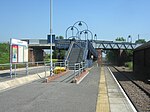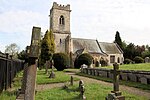Ulleskelf

Ulleskelf is a village and civil parish in the Selby District of North Yorkshire, England, four miles from Tadcaster on the River Wharfe. Its name comes from the Scandinavian personal name Úlfr, while skelf may be an Old English word meaning "a flat area" (a cognate of shelf), although it could be from the Old Scandinavian equivalent, 'skialf' as in several other English place names, e.g. Hunshelf, Wadshelf. In this geographical context 'skelf' would mean 'bank' (of the river). The settlement was recorded in the Domesday Book as Oleschel and Oleslec.The village was historically part of the West Riding of Yorkshire until 1974.It is served by Ulleskelf railway station, operated by Northern. It has one public house (the Ulleskelf Arms) and one shop (Post Office/general store). The 2011 UK Census recorded the population of the parish as 980. Ulleskelf village hall was previously the Church of England) church of St Saviour. The Methodist church is still in use. "Mind Games", an episode of TV detective series A Touch of Frost, was filmed in the village in 2008.
Excerpt from the Wikipedia article Ulleskelf (License: CC BY-SA 3.0, Authors, Images).Ulleskelf
Geographical coordinates (GPS) Address Nearby Places Show on map
Geographical coordinates (GPS)
| Latitude | Longitude |
|---|---|
| N 53.85488 ° | E -1.21267 ° |
Address
LS24 9DS
England, United Kingdom
Open on Google Maps










